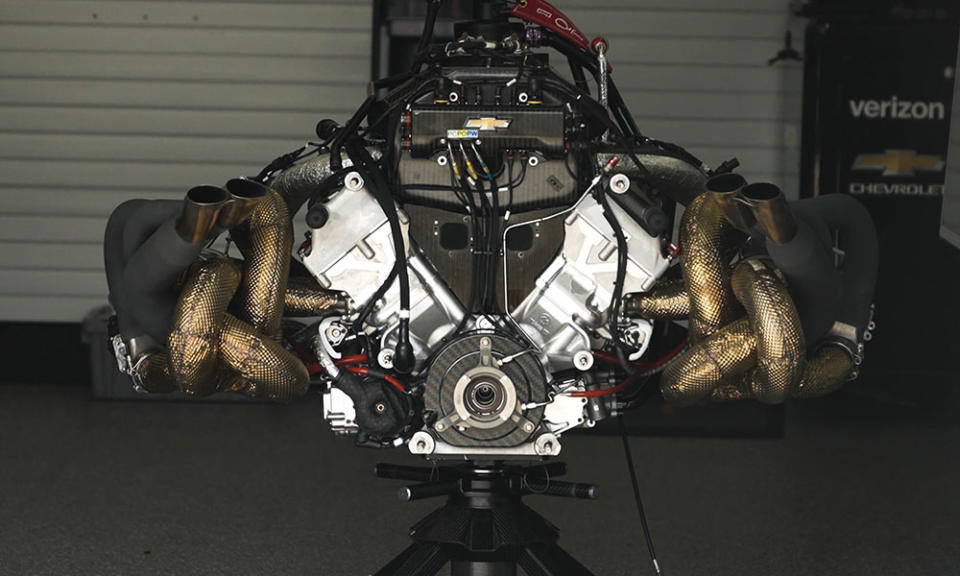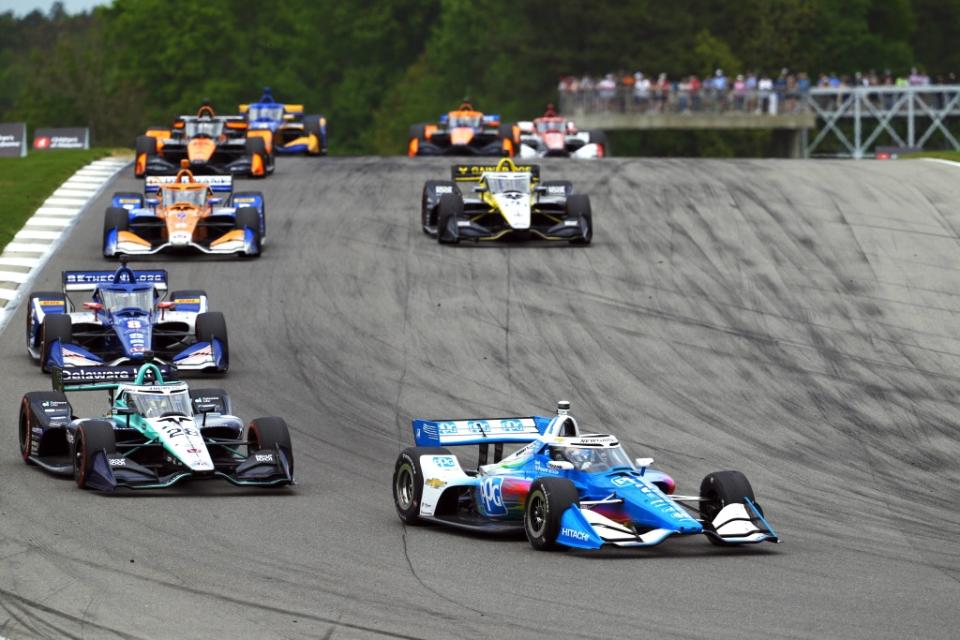IndyCar 2027 engine ideas rounding into focus

There’s plenty of life left in IndyCar’s current engine formula that debuted in 2012, and at the moment, it’s looking like the formula will continue as the series’ preferred solution for years to come.
At a compact displacement of 2.2 liters (134 cubic inches) arranged in a V6 format with two turbos helping the tiny motors to make upwards of 750hp at high boost settings, the engines made by Chevrolet through its partners at Ilmor Engineering and by Honda Racing Corporation US are exceptionally refined as they compete in their 13th IndyCar season.
Penske Entertainment, owners of the IndyCar Series, has spoken on a regular basis about replacing the 2.2-liter TTV6 formula with something different in 2027, and RACER understands the plan to alter its internal combustion engine (ICE) regulations is moving forward. But not in the way that might have been anticipated.
There’s plenty of time for things to change before anything becomes written in stone, but according to multiple sources, the current line of thinking would be to continue with the existing, custom motors built by Chevy and Honda.
Rather than initiate an all-new formula, the modification to the regulations would center on allowing each manufacturer to keep their pools of 60-plus engines, which would cut the need to allocate massive design, development, and build budgets to create new ICE solutions for 2027, and place new restrictions on further developing the 2.2L motors.
There was a lot of talk late in 2023 about shifting IndyCar’s next ICE formula to a spec engine that could be acquired by any manufacturer to brand as their own, but that notion has taken a backseat in favor of applying a spec-minded approach to the current motors.
If this line of thinking holds, today’s engines would be largely locked down in the next year or two at whatever state of development agreed upon by the series and its manufacturers. Once that were to happen, a wide-ranging list of R&D limitations would be implemented to further reduce the annual monetary outlay to participate as IndyCar engine suppliers.
The overarching goal would be to reduce the emphasis on IndyCar’s ICE, both through sweeping budget cuts and, to a lesser degree, on the promotions side, and place a much bigger spotlight on hybridization with energy recovery systems (ERS) in the next formula.
RACER understands a desire exists among manufacturers — those in the series and those who’ve spoken to the series — to open up the ERS regulations in some manner with the next formula change since hybridization is becoming a more relevant area for many auto manufacturers in their road car offerings.
What isn’t clear is what a future IndyCar ERS package might look like.
In action during a race, IndyCar’s ESS will not provide long stretches of power without a need for drivers to recharge the supercapacitors. Richard Dole/Motorsport Images
For what’s being readied to debut in July at Mid-Ohio, IndyCar’s first ERS unit, which was created in a combined effort by Chevy and Honda for the series, is specific to the current Dallara DW12 chassis and has certain limitations that had to be accepted.
In needing to devise and fit ERS units into a chassis model that launched in 2012, Chevy — working with Empel on the motor generator unit (MGU) — and Honda — working with Skeleton on the supercapacitor energy storage system (ESS) — were left to create an ERS package that lives in the bellhousing, which is far from optimal.
With the rest of the chassis filled with auxiliaries for the ICE and the rest of the drivetrain, the cavity inside bellhousing, which bridges the ICE and transmission, was the only open space that could be found in the DW12 to house the ERS.
The resulting ERS units are marvels of engineering that can pack more than a 100hp punch, but the tight confines of the bellhousing meant Honda had to create a small low-voltage supercapacitor pack to deal with the extreme lack of space that made it impossible to use a battery.
Supercapacitors — which IndyCar has chosen to call ultracapacitors — are renowned for their ability to charge and deploy energy at a rapid rate, but their only drawback is they can only store a limited amount of energy. In action during a race, IndyCar’s ESS cannot provide long stretches of power without a need for drivers to recharge the supercapacitors.
Looking a few years down the road, the series and its manufacturers could elect to hold onto the ERS units that will go live this summer and allow auto brands to modify and improve chosen areas of the systems. Or, if the conversation swings towards going an all-new high-voltage ERS package that makes use of a larger battery, manufacturers would be granted areas within that system to focus most of their R&D budgets.
Trading today’s low-voltage ERS for a new high-voltage system that relies on a battery to hold and return more energy, would require the series to commission a new chassis with the placement of the battery designed into the tub in a similar method to what’s found in Formula 1.
The last area of interest, which could also change before new regulations are agreed upon, is found with how new manufacturers would be welcomed into the series. With the current suppliers and the series dedicated to making the ICE something close to spec, and with no guarantee Honda will sign on to stay in the series after its current contract expires following the 2026 season, sources have told RACER that Ilmor could become IndyCar’s chosen vendor to supply new manufacturers with most — but maybe not all — of the major components needed to assemble their own engines.
Some degree of ICE freedom is desired by Chevy and Honda, which makes producing a truly spec engine a non-starter at the moment.
Roger Penske, while courting Toyota within the last two years, offered the same kind of support — most of the big parts that comprise Chevy’s championship-winning motors — from Ilmor, which he co-founded and co-owns, to ease and expedite Toyota’s ability to join IndyCar as its third manufacturer. Although Toyota ultimately passed on the opportunity, the same concept has been retained to entice other manufacturers to join at the next formula changeover.
Penske Entertainment CEO Mark Miles added another facet to close the topic on when IndyCar’s next-generation hybrid powertrain would appear in competition.
“I would say the work continues,” Miles told RACER. “It’s really solid. The way I think of it is as early as ’27. But I don’t think we want to get locked into saying it’s definitely ’27 until we know that it would be.”

 Yahoo Autos
Yahoo Autos 
